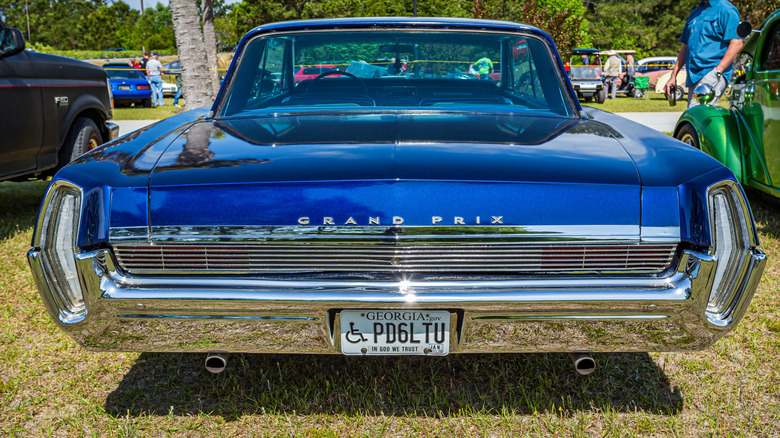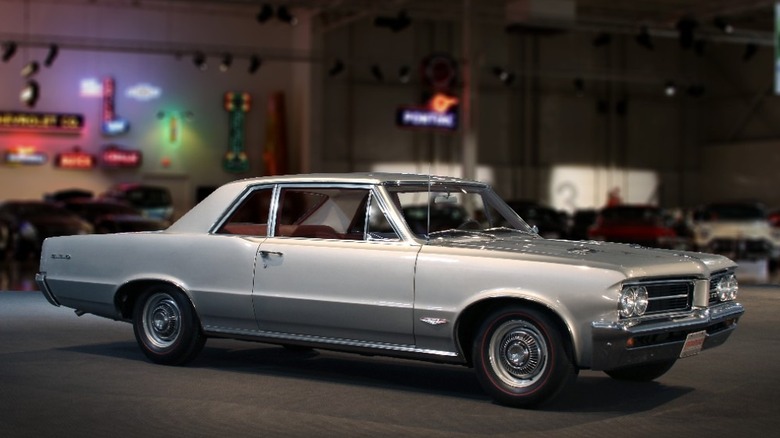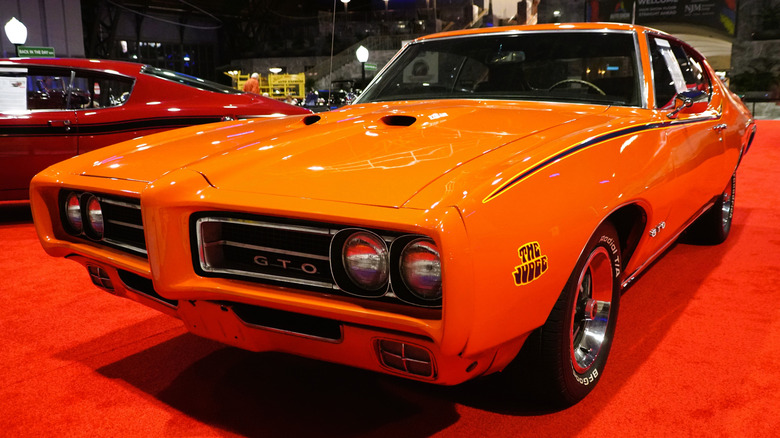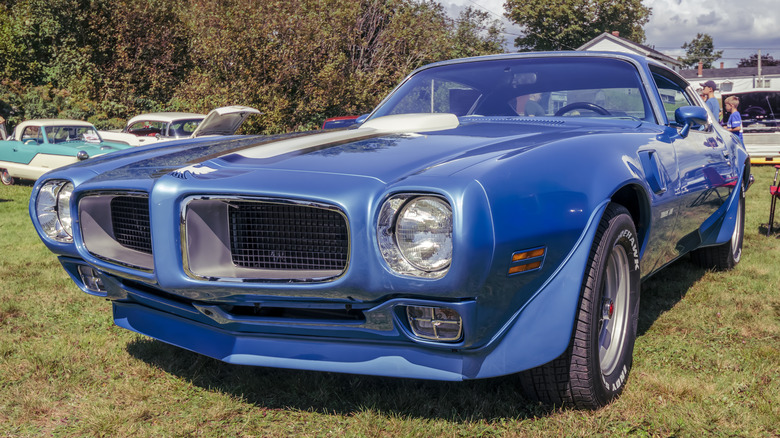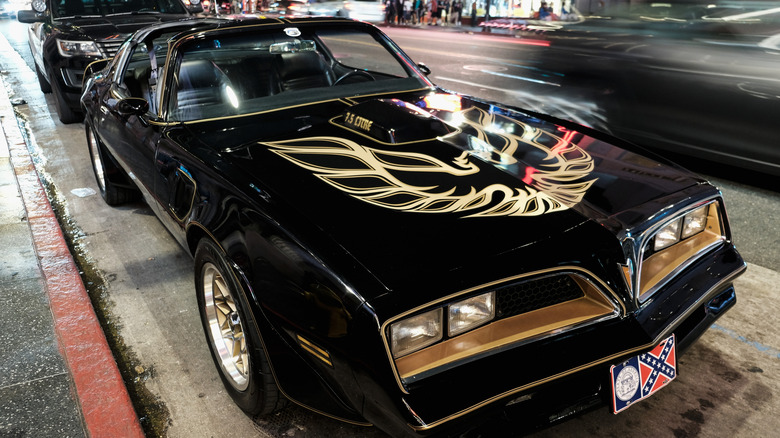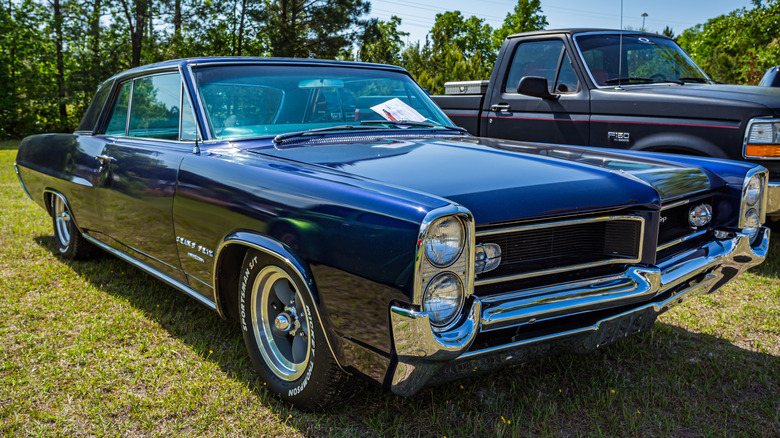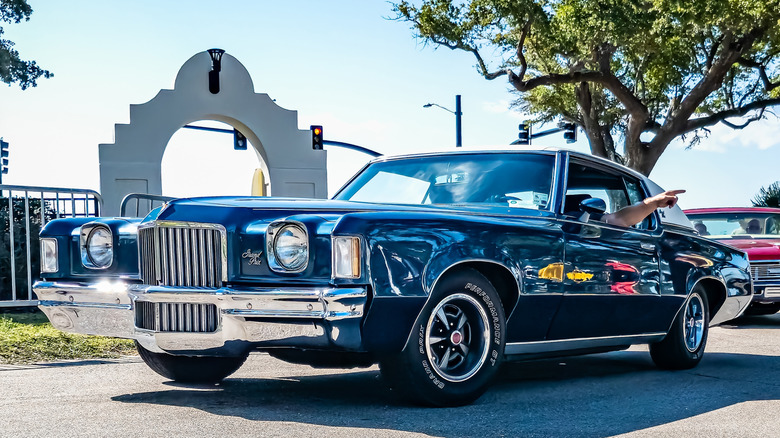6 Of The Most Sought After Classic Pontiac Muscle Cars
Pontiac muscle cars have earned a chapter all to themselves in muscle car history. After 20-plus years of relying on the Silver Streak design for its identity within the GM hierarchy, Pontiac decided on a different direction as it entered the 1960s. Chrome strips down the hood were out, and performance was in. Pontiac's new image was built upon such innovations as the Wide-Track chassis, split grille, Firebird's beak, and the GTO's Endura front bumper. Underpinning the visual sizzle of Pontiac's signature design features was the horsepower to back up what the sheet metal promised. Pontiac led the way during the muscle car heyday, producing many sought-after muscle cars that are still in demand today.
These cars' names are a tribute to the Pontiac brand and the legendary performance it once stood for — GTO, Trans Am, and Grand Prix. Since we are after "classic" Pontiac muscle cars here, our focus will be on models from the 1960s and early 1970s. Those were the years that the muscle car wars were in full swing, and came before the tough times of emissions controls and severe horsepower cuts. My personal expertise regarding these vehicles comes form my extensive experience writing about classic cars and their values. You can refer to my recent SlashGear articles on the Yenko Camaro's value and significance, limited-edition Ford Mustangs, affordable classic convertibles, and more. For reference on the value of these classic Pontiac models, I relied on sales listings from Classic.com and previous reporting here on SlashGear.
1964-67 GTO
Although not the first of its kind, the 1964 GTO was an important part of muscle car history. Initially offered as a performance package for the Le Mans, the GTO was made a stand-alone model in 1966. The 1964-67 GTO represented the first generation of this sought-after muscle car. It came standard with the 389 cubic inch V8 from the Grand Prix combined with the heads from Pontiac's larger 421 high output engine. The 10.4:1 compression ratio this configuration produced required premium gas. A high-lift cam was added to the mix, boosting standard horsepower to 325.
With the optional Tri-Power package that included three two-barrel Rochester carburetors, the GTO cranked out 348 horsepower and 428 pound-feet of torque. Transmission options included a two-speed automatic, a three-speed manual, and a four-speed manual with close- or wide-ratio gearing.
The GTO's engineers also placed some priority on its ability to go around corners. The upgraded suspension had stiffer shocks, wider wheels, a heavy-duty anti-roll bar in the front, and high-performance low-profile tires. There is still a plentiful supply of first-generation GTOs available for sale, although they aren't cheap. For the month leading up to this writing, Classic.com shows 40 sales of 1964-67 GTOs at an average price of just over $70,000.
1968-72 GTO
Next up, we have the second generation of the Pontiac GTO, which started with the 1968 models and ran through 1972. The second-gen GTO presented a fresh, new look, with its body-colored Endura front bumpers and swoopy coke-bottle body styling. The 400 cubic-inch Pontiac V8 with 350 horsepower became the base engine, and more powerful Ram Air engines were available as options. The GTO "The Judge" package with special graphics, hood scoop, and rear spoiler was added in 1969. The model got a facelift in 1970, when a new 455 cubic inch V8 also made the option sheet. Sadly, power ratings took a slide in 1971 and would not bounce back for a very long time.
The tide had turned against the muscle car trend. The toll taken by emissions controls, increased insurance rates, and the decision to switch to net horsepower ratings had made it pointless to promote a car's performance. The GTO went back to its origins as an option package on the Le Mans once again in 1972. The model became a shadow of its former self before fading away for good after the 1974 model year (the later Holden-based GTO doesn't really count).
For the month leading up to this writing, Classic.com shows 53 sales of second-gen GTOs at an average price of $98,322. Six-figure prices were commanded by 10 of those, and a 1969 Judge convertible sold in January for $313,500.
Early second-generation Trans Am
When ranking every generation of the Pontiac Trans Am, we put the 1970-81 second generation at the very top. As the Firebird's performance variant, it showcased a standard 400 cubic-inch, 345-horsepower Ram Air III V8 mated to a four-speed manual transmission.
Also included in the Trans Am package were an upgraded suspension with special shocks and springs, variable-ratio power steering, ventilated disc brakes, a limited-slip differential, and Firestone Wide Oval tires. A functional hood scoop, fender-mounted air extractors, and front and rear spoilers completed the exterior appearance. Inside, you were treated to a Hurst shifter and an engine-turned dash panel. Paint choices were initially limited to white with blue stripes or blue with white stripes, but additional colors were made available later.
These initial second-gen Firebird Trans Ams had all of their performance bona fides, since they were released before new emissions standards began to bite hard. This has made them valuable on the secondary market. Classic.com shows 85 sales of second-generation Trans Ams in the month leading up to this writing, at an average price of just under $63,000. Examples from 1970 and 1971 that preceded the new emissions restrictions are particularly desirable. The 17 1970 examples that sold over that same time frame went for almost $87,000, and 22 1971 models fetched an average of $81,200.
1977-78 Smokey and the Bandit Firebird Trans Am
The 1977 Trans Am (actually an updated '76) decked out in the black-and-gold Special Edition Package had a starring role in the 1977 film "Smokey and the Bandit" starring Burt Reynolds.
This being the late 1970s, horsepower ratings on these "Smokey and the Bandit" Trans Ams were nowhere near those of the early '70s versions. Production Trans Ams of this vintage with a 6.6-Liter V8 put out just 200 horsepower, a far cry from the 1970 1/2 model's 345 horses.
The "Smokey and the Bandit" Trans Am and its movie-based antics blasted into the public consciousness in a huge way. Customers rushed into Pontiac showrooms across the land, pushing Trans Am sales through the roof. From a low of 46,701 in 1976 — the year before the movie was released — sales increased rapidly to a high of 117,108 cars in 1979.
The notoriety achieved by this vehicle has positively impacted the values of the 1977 and 1978 Special Edition Trans Ams that share the same styling as the movie car. Classic.com shows four 1977 "Smokey and the Bandit" Special Edition Trans Am sales at six-figure prices over the last year, with one going at auction last fall for $180,000. Four 1978 examples have sold over that same span for an average price of just over $50,000.
In comparison, standard-edition Trans Ams from those two model years go for around $40,000.
1962-68 Grand Prix
The 1962-68 Pontiac Grand Prix was the first generation of the brand's personal luxury car. The Grand Prix had a bucket-seat interior and a center console to match. Its standard 389 cubic-inch Pontiac V8 produced 303 horsepower, with the optional 348-horsepower Tri-Power setup available two years before the GTO was introduced. A very rare engine is the 1962-only 421 cubic-inch Super Duty with 405 horses — only 16 of these were produced.
The Grand Prix was conceived by John DeLorean, who was Pontiac's Head of Advanced Engineering back then. The Grand Prix was intended to go up against the contemporary version of the Ford Thunderbird, which had grown from a two-seat sports car into a four-place luxury coupe. The Grand Prix added a healthy dose of performance on top of what the T-bird offered.
DeLorean's vision translated into solid sales for the Grand Prix, especially after a complete restyle for the 1963 model year. GP sales more than doubled after the redesign, to 72,959 units in 1963. Then came the GTO's debut in 1964 and everything changed. Smaller cars like the GTO took the spotlight and Grand Prix sales started to slide. Refreshed styling for the Grand Prix came in varying degrees on an annual basis. A one-year-only convertible appeared for 1967, but the marketplace's tastes had changed. Full-size cars were out of favor.
First-gen Grand Prix sales on Classic.com in the three months leading up to this writing number just four cars. Prices range from $24,200 to a high of $107,800 for a 1965 coupe with the 421 Tri-Power option.
1969-72 Grand Prix
For its 1969-72 second generation, the Grand Prix sat on the smaller G-body platform. A prominent, upright front grille at the end of a very long hood made a powerful first impression. Inside, the Grand Prix offered a wraparound dash, plush bucket seats, and a floor shifter.
The standard Grand Prix engine was a 350-horsepower version of the 400 cubic-inch Pontiac V8, the same as you would get in a Trans Am or GTO. Trim levels were inspired by Duesenberg, with S for the base trim and SJ representing the sportier version. SJs came with the 428 cubic-inch, 370-horsepower mill, while a 390-horse high output version was option on SJ models. In 1970, the 455 cubic-inch V8 replaced the previous 428.
Classic.com lists 17 sales of second-gen Grand Prix models over the past year, at an average price of just under $33,000. That makes it the top-ranked Grand Prix generation in terms of resale value.
